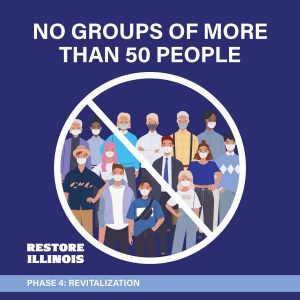20 Illinois counties at warning level as COVID-19 outbreaks reported
Chronicle Media — August 21, 2020
The Illinois Department of Public Health (IDPH) on Friday, Aug. 21 reported 20 counties in Illinois are at a warning level for COVID-19.
A county enters a warning level when two or more risk indicators that measure the amount of COVID-19 increase.
Twenty counties are currently reported at a warning level – Bureau, Cass, Clay, Clinton, Franklin, Greene, Grundy, Hancock, Henderson, Jefferson, Logan, Madison, Monroe, Moultrie, Randolph, St. Clair, Union, White, Will, and Williamson.
These counties saw cases or outbreaks associated with weddings, businesses, neighborhood gatherings, parties, long-term care facilities and other congregate settings, travel to neighboring states, bars, sports camps, and spread among members of the same household who are not isolating at home.
Cases connected to schools are also beginning to be reported.
Public health officials are observing people not social distancing or using face coverings. Additionally, there are reports of individuals who are ill attributing their symptoms to allergies or other illnesses, or not being forthcoming about their symptoms or close contacts, according to the IDPH.
Several counties are taking swift action and implementing mitigation measures to help slow spread of the virus, including working to increase testing in their communities and launching mask campaigns such as “Masks on Faces Keeps Places Open.”
IDPH uses numerous indicators when determining if a county is experiencing stable COVID-19 activity, or if there are warning signs of increased COVID-19 risk in the county.
- New cases per 100,000 people. If there are more than 50 new cases per 100,000 people in the county, this triggers a warning.
• Number of deaths. This metric indicates a warning when the weekly number of deaths increases more than 20 percent for two consecutive weeks.
• Weekly test positivity. This metric indicates a warning when the 7-day test positivity rate rises above 8 percent.
• ICU availability. If there are fewer than 20 percent of intensive care units available in the region, this triggers a warning.
• Weekly emergency department visits. This metric indicates a warning when the weekly percent of COVID-19-like-illness emergency department visits increase by more than 20 percent for two consecutive weeks.
• Weekly hospital admissions. A warning is triggered when the weekly number of hospital admissions for COVID-19-like-illness increases by more than 20 percent for two consecutive weeks.
• Tests perform. This metric is used to provide context and indicate if more testing is needed in the county.
• Clusters. This metric looks at the percent of COVID-19 cases associated with clusters or outbreaks and is used to understand large increase in cases.
These metrics are intended to be used for local level awareness to help local leaders, businesses, local health departments, and the public make informed decisions about personal and family gatherings, as well as what activities they choose to do. The metrics are updated weekly, from the Sunday-Saturday of the prior week.
A map and information of each county’s status can be found on the IDPH website at https://www.dph.illinois.gov/countymetrics.
State asks for outside investigation of its nursing home oversight board








